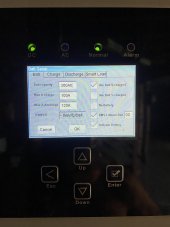RazerMackham
New Member
- Joined
- Sep 3, 2021
- Messages
- 6
*Edit: I figured out how to utilize the battery to inverter communication, explained in my next comment*
Hello everyone, I am off grid, with a Sol-Ark 12k, 6200W of panels, and two Kilovault HAB 150AH batteries in parallel. Going by the battery manual, p30, it says to set the charging profile to “2 stage no float” which is unavailable on the Sol-Ark. I put the recommended settings, as best I could figure, but I’m pretty sure I need to change the float voltage value.
*I do have ‘load first’ checked under sell control in the Sol-Ark menus if this makes any difference*
The issue I’m running into is that the batteries are charging up to the absorption voltage (56.0V) during the day, then the inverter draws from the batteries until they reach the float value (52.8), at which point the inverter starts to draw power from the panels, while keeping the batteries at the float value.
I emailed Kilovault and told them that their Manual was confusing, because on p11, it gives a “Recommended Floating Charge Voltage of 55.2V” to which they responded that was a typo in the manual and to use a float of 52.8V.
My understanding of Lithium battery chemistry is that it doesn’t behave the same way as lead acid, and that there’s a more direct correlation between the voltage and the state of charge, so putting the float at 55.2V makes sense if I want to keep my batteries full by the time the sun goes down.
Tl;dr
If I set my float voltage to 52.8V, per the manual, I will fully charge my batteries during the day, then discharge to the float value, wasting solar and also adding charge cycles to the battery, leaving me at roughly 65% state of charge to get me through the night.
I think I should set the float value to 55.2V, I just want to check with folks who are more knowledgeable than me as to what’s best for my batteries.
Hello everyone, I am off grid, with a Sol-Ark 12k, 6200W of panels, and two Kilovault HAB 150AH batteries in parallel. Going by the battery manual, p30, it says to set the charging profile to “2 stage no float” which is unavailable on the Sol-Ark. I put the recommended settings, as best I could figure, but I’m pretty sure I need to change the float voltage value.
*I do have ‘load first’ checked under sell control in the Sol-Ark menus if this makes any difference*
The issue I’m running into is that the batteries are charging up to the absorption voltage (56.0V) during the day, then the inverter draws from the batteries until they reach the float value (52.8), at which point the inverter starts to draw power from the panels, while keeping the batteries at the float value.
I emailed Kilovault and told them that their Manual was confusing, because on p11, it gives a “Recommended Floating Charge Voltage of 55.2V” to which they responded that was a typo in the manual and to use a float of 52.8V.
My understanding of Lithium battery chemistry is that it doesn’t behave the same way as lead acid, and that there’s a more direct correlation between the voltage and the state of charge, so putting the float at 55.2V makes sense if I want to keep my batteries full by the time the sun goes down.
Tl;dr
If I set my float voltage to 52.8V, per the manual, I will fully charge my batteries during the day, then discharge to the float value, wasting solar and also adding charge cycles to the battery, leaving me at roughly 65% state of charge to get me through the night.
I think I should set the float value to 55.2V, I just want to check with folks who are more knowledgeable than me as to what’s best for my batteries.
Attachments
Last edited:





